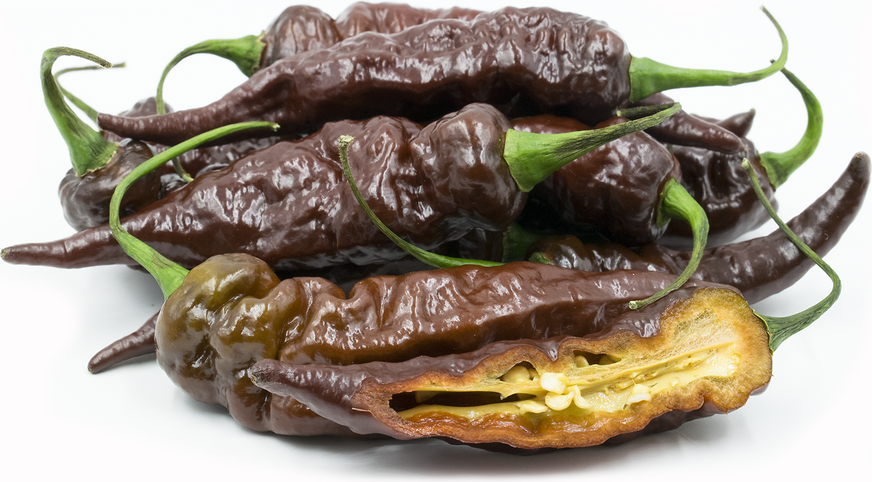


Chocolate Ghost Chile Pepper
Estimated Inventory, 8 ct : 0
Description/Taste
Chocolate ghost chile peppers widely vary in size, shape, and spice depending on the soil and climate the plant is grown in. The gnarled, creased pods typically average 5 to 8 centimeters in length and 2 to 3 centimeters in diameter and have a conical shape that tapers to a slender, distinct point on the non-stem end. Slowly maturing from green, red, to dark brown, the skin is glossy and smooth, covered in many wrinkles giving the pods a crinkled appearance. Underneath the surface, the flesh is semi-thick, crisp, and light brown with a floral scent, encasing a central cavity filled with large membranes and a few, round, flat, and cream-colored seeds. Chocolate ghost chile peppers have a fruit-forward, subtly sweet, tangy, and smoky flavor followed by a delayed heat that gradually builds in intensity. The heat may not develop until 30 to 45 seconds after consuming, but it can linger in intensity on the palate for a prolonged period.
Seasons/Availability
Chocolate ghost chile peppers are available in the late summer through early fall.
Current Facts
Chocolate ghost chile peppers, botanically classified as Capsicum chinense, are a rare and extremely hot variety from India that belongs to the Solanaceae or nightshade family. Believed to be a natural variant of the red ghost pepper, Chocolate ghost chile peppers range 800,000 to 1,001,304 SHU on the Scoville scale and have a scorching, lingering heat that can last more than thirty minutes after consumption. Chocolate ghost chile peppers are also known as Chocolate Bhut Jolokia, which is the Indian name for the pepper. The word bhut stems from Bhutia, which is one of the first Indian tribes to trade the pepper, and bhut also roughly translates to mean ghost. Chocolate ghost peppers are highly regarded among specialty growers as a variety with complex flavors and eye-watering heat. The peppers are most commonly blended into hot sauces and are used in very small amounts as a flavoring.
Nutritional Value
Chocolate ghost chile peppers are an excellent source of vitamins A and C and contain a moderate amount of folate, which is a B vitamin that can help repair tissues within the body. The peppers also contain a very high amount of the chemical compound known as capsaicin, which triggers pain receptors in our body to feel the sensation of burning. Capsaicin has been shown to have anti-inflammatory properties and causes the body to release endorphins to counteract the perceived pain.
Applications
Chocolate ghost chile peppers must be used with extreme caution due to the intensity of the spice. Gloves and goggles are also recommended when handling or slicing the pepper. When fresh, Chocolate ghost peppers can be chopped into salsas or tossed into stews, chilis, and curries. The peppers can also be added to cooked meats, simmered in bean dishes, infused into sea salt, or blended into pizza sauce. It is important to note that a little Chocolate ghost chile pepper goes a long way and, in many recipes, only a small portion of the pepper will be used. In addition to fresh applications, Chocolate ghost chile peppers are popularly used in hot sauces, dips, and marinades. They are also dried and ground into a powder for use as a spice. Chocolate ghost peppers pair well with meats such as beef, pork, poultry, lamb, and fish, tomatoes, red onions, garlic, ginger, cilantro, rice, and spices such as garam masala, cumin, and coriander. Fresh peppers will keep 1-2 weeks when loosely wrapped in plastic and stored in the refrigerator.
Ethnic/Cultural Info
Among the local tribes of northeastern India, bhut jolokia chile peppers are unknown as one of the world’s hottest peppers or as a social media star, but they are regarded as the “king chile” and are used in almost every meal as a source of flavor. Bhut jolokia chile peppers develop their flavorful taste and intense heat through the unique terroir of northeastern India. Local tribes utilize the peppers for their sweet, fruity flavor and blend the peppers into iromba, which is fish cooked in a spiced sauce and served over rice. The peppers are also mixed into curries, pork dishes, and chutneys. From culinary applications to medicinal remedies, many local tribes, especially the Kuki, believe the pepper is a part of their lifeblood and soul. The Kukis even used the pepper as one of the first versions of a smoke bomb by tying the peppers to a log, setting them on fire, and throwing them into neighboring villages as a flaming declaration of war.
Geography/History
Chocolate ghost chile peppers were first discovered as a natural variation of the red bhut jolokia pepper by Frontal Agritech in Assam, India. The spicy pepper is likely a cross between the red ghost pepper and the brown pepper variety, 7 pot douglah. Released worldwide in 2008, Chocolate ghost chile peppers are not usually seen fresh in commercial markets and are a rare variety sold through specialty platforms. Chocolate ghost chile peppers are grown in the states of Assam, Nagaland, and Manipur, located in the small northeastern panhandle of India, and they are also available in seed form through online catalogs. Outside of India, the pods are most often grown by chile pepper enthusiasts and are found at farmers markets through specialty pepper farms in the United States, Europe, Australia, and Asia.
Recipe Ideas
Recipes that include Chocolate Ghost Chile Pepper. One




